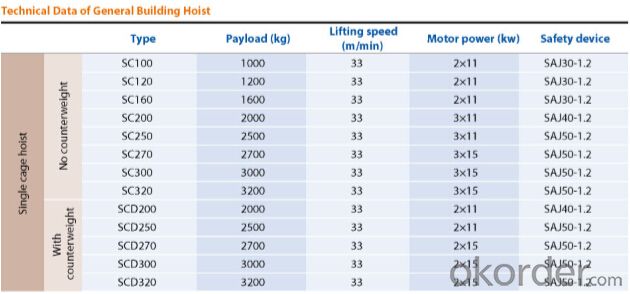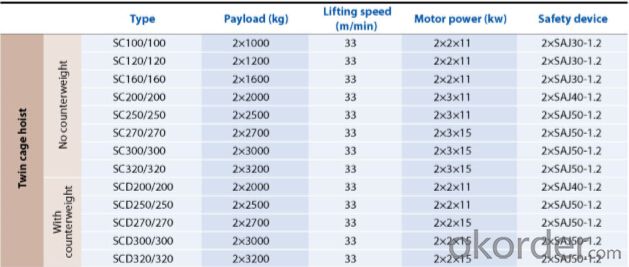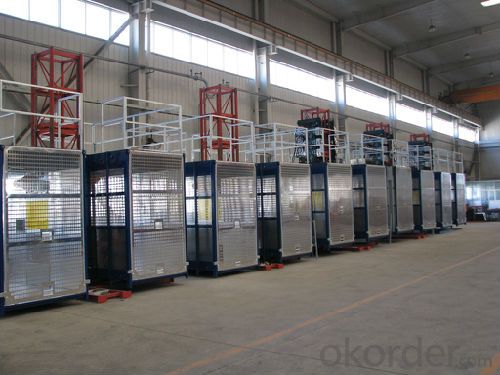Construction Hoist Building Lifter SC250
- Loading Port:
- China main port
- Payment Terms:
- TT or LC
- Min Order Qty:
- 1 unit
- Supply Capability:
- 30 unit/month
OKorder Service Pledge
OKorder Financial Service
You Might Also Like
Structure of Construction Hoist Description
Feature: Construction Hoist Condition: New Application: Construction
Payload(kg):2500 Lifting Speed(m/min):33 Motor Power(kw): 3*11
Safety Device: SAJ50-1.2 Cage: Single Counterweight: No
Certification: CE,ISO Place of Origin: China(Mainland) Model Number: Type:SC250
Packaging & Delivery of Construction Hoist
Packaging Detail: Nude package Delivery Detail: 25-30days
Main Parts of Construction Hoist
● The gearing adopts imported bearing, enameled cable, and oil seal.
● The electric parts adopt products from world renowned manufactures such as Schneider, Siemens, and LG.
● The racks and pinion adopts special material and heat-treatment technique, which prolong the life of these parts.
● The steel structure uses quality steel from famous domestic manufactures.
● The surface of the structure can apply paint-spray, parkerozing baking finish or hot galvanizing processing according
to users requirements,
● The cage can be produced and decorated by aluminum molded board, punched-plate or figured aluminm board.
Construction Hoist Specifiction







FAQ of Construction Hoist
Q: What is the building hoist main purpose?
A: Building hoist equipped with double or single cabin to transport the materials and labors up and down. It's the ideal
construction equipment for vertical transportation in the field of construction.
Q: What is the main structure of building hoist?
A: The P/M construction hoist mainly contains metal structure, driving system, electrical control system, cable guide &
protection system, electrical top crane and safety device.
Q: What is the meaning of the building hoist’s code?
A: Take SC200/200 for example: “SC” stands for rack and pinion hoist, “200/200” stands for double cage and capacity
is 2 tons per cage. “SC200” stands for single cage and capacity is 2 tons.
- Q: This question seeks to understand the various types of electric lifting equipment utilized in the construction industry.
- <p>In the construction industry, various types of electric lifting equipment are used to facilitate the movement of heavy materials and equipment. Some of the common types include: 1. Electric Hoists: These are used for vertical lifting and lowering of loads. 2. Electric Cranes: They are mobile lifting machines with a long boom and can move loads horizontally and vertically. 3. Electric Forklifts: They are used for lifting and transporting heavy loads in a warehouse or construction site. 4. Electric Scissor Lifts: These are mobile platforms that can be raised to allow workers to reach high areas. 5. Electric Stackers: Used for stacking and unstacking materials in a warehouse. 6. Electric Pallet Trucks: These are used for moving heavy pallets of materials. Each type of equipment serves a specific purpose and is chosen based on the requirements of the construction project.</p>
- Q: This question asks if building hoists are capable of moving large or heavy objects.
- <p>Yes, building hoists are specifically designed to move large and heavy objects vertically in construction settings. They are used to lift materials such as bricks, concrete, and steel beams to various levels of a building under construction. Building hoists are engineered to handle significant weight and are an essential tool for efficient material transport in tall structures where cranes may not be practical or safe for frequent use.</p>
- Q: This question asks for guidance on selecting an appropriate building hoist for specific requirements.
- <p>Choosing a suitable building hoist involves several considerations. First, assess the load capacity needed based on the weight of materials to be lifted. Consider the hoist's lifting height to ensure it covers the building's full height. Evaluate the frequency of use and the speed required for efficient material movement. Safety features are crucial; look for hoists with certifications and safety mechanisms like overload protection. Check the hoist's durability and maintenance requirements. Finally, consider the cost, including purchase price, operation, and maintenance expenses. Consulting with hoist manufacturers or rental companies can provide personalized advice tailored to your project's specific needs.</p>
- Q: Is it possible for a single lifting device to simultaneously lift multiple objects with varying weights?
- <p>Yes, a single lifting device can be used to lift multiple objects at once with different weights, provided the total weight does not exceed the device's lifting capacity. The device must be designed to handle the combined weight and ensure even distribution of the load. Safety measures and proper securing of the objects are crucial to prevent accidents. It's important to follow the manufacturer's guidelines and never exceed the maximum load capacity to avoid damage or injury.</p>
- Q: Is it possible to use a building hoist for the transportation of goods or materials?
- <p>Yes, building hoists are commonly used to transport goods and materials in construction projects. They are designed to lift and lower heavy materials such as bricks, cement, and tools, making the construction process more efficient and reducing the need for manual labor. Building hoists are equipped with safety features to ensure the secure transportation of materials, and they are an essential tool in many construction sites.</p>
- Q: What are the primary roles or purposes that a building hoist serves in construction?
- <p>Building hoists, also known as construction hoists, serve several essential functions in construction projects. They are primarily used for the vertical transportation of workers, materials, and equipment within a building under construction. They increase efficiency by reducing the time and effort required to move materials and personnel, ensuring a faster construction process. Hoists also enhance safety by providing a controlled and secure means of vertical transportation, reducing the risk of accidents associated with manual material handling. Additionally, they contribute to the overall project timeline by allowing for simultaneous work on multiple floors, improving the coordination of construction activities.</p>
- Q: This question asks for safety precautions that should be taken when using a building hoist, which is a type of lifting equipment used in construction.
- <p>Safety measures for using a building hoist include regular inspections and maintenance, ensuring all safety devices are in good working order, securing all loads properly, and not overloading the hoist. Operators must be trained and certified. Protective barriers should be in place to prevent unauthorized access. Emergency stop switches should be readily accessible. Workers should wear appropriate personal protective equipment, and communication between the hoist operator and those on the ground should be clear and effective. Adhering to these measures helps prevent accidents and ensures the safe operation of the building hoist.</p>
- Q: Is it possible to utilize a building hoist for the transportation of heavy objects?
- <p>Yes, building hoists are specifically designed to move heavy objects vertically within a construction site. They are used to lift and lower materials such as concrete, bricks, and other construction supplies. Building hoists are equipped with strong cables and a robust mechanism to handle significant weight, making them ideal for heavy-duty lifting tasks in construction projects. However, it's crucial to ensure that the hoist is operated within its weight capacity and safety guidelines are strictly followed to prevent accidents.</p>
- Q: This question asks for guidance on selecting appropriate lifting equipment based on specific requirements and work conditions.
- <p>To choose the right type of lifting equipment for your specific needs and work environment, consider the following: 1. Load capacity: Ensure the equipment can handle the weight of the items you need to lift. 2. Workspace: Evaluate the size and layout of your work area to determine the appropriate size and type of equipment. 3. Safety features: Look for equipment with safety features that meet your industry's standards. 4. Mobility: Consider whether you need a mobile or stationary unit. 5. Compatibility: Ensure the equipment is compatible with other tools or machinery you use. 6. Budget: Determine your budget and find equipment that offers the best value for your investment. 7. Consult with experts: Speak with equipment manufacturers or distributors to get their recommendations based on your specific needs. Always prioritize safety and efficiency when selecting lifting equipment.</p>
- Q: Is it possible to utilize building hoists for the transportation of materials and equipment within construction sites?
- <p>Yes, building hoists are commonly used in construction sites to move materials and equipment. They are designed to lift and lower heavy loads vertically, making them ideal for transporting construction materials, tools, and equipment between different floors or levels of a building under construction. This equipment significantly enhances efficiency and safety on construction sites by reducing manual labor and the risk of accidents associated with manual handling of heavy items.</p>
Send your message to us
Construction Hoist Building Lifter SC250
- Loading Port:
- China main port
- Payment Terms:
- TT or LC
- Min Order Qty:
- 1 unit
- Supply Capability:
- 30 unit/month
OKorder Service Pledge
OKorder Financial Service
Similar products
Hot products
Hot Searches
Related keywords





























